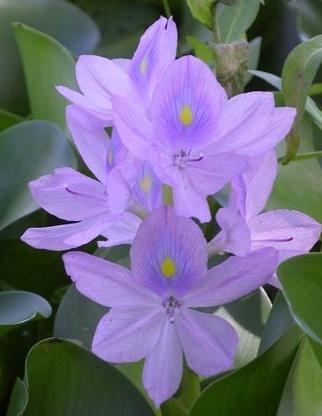How fascinating the water is when beautiful flowers float on top of it ! Water hyacinth, green plague or Eichornia - all these names and nicknames belong to one plant, amazing and unique. This flower fascinates with its pristine beauty.
Description and features of the flower
This plant seems to glide over the surface of the water, attracting the attention of fish and other inhabitants of the reservoir. Its leaves form a rosette. At the same time, inside the blisters there is an air-bearing tissue, which acts as a float, due to which the plant stably stays on the surface. If water hyacinth grows in distance from other plants, then the swell resembles real air bubbles, which do not allow small ripples and waves to overturn it into the water. When there are many of his other brothers around him, then in such protection the need disappears, and the swellings become much smaller in size. As a result, they become elongated, bottle-shaped.
All inflorescences are purple-blue or yellow-pink in color, somewhat similar to hyacinth flowers growing in garden plots. Dark blue spots are located on the petals of this plant, and six stamens adorn the middle of the flower. In the wild, hyacinth multiplies by pollination, forming a three-nest box, inside of which there are seeds. In the period of a decrease in the water level in rivers, they dissipate, after which they settle on silt, where they shoot.
In order for water hyacinth to bloom, it needs an open pond, illuminated by the sun. This flower simply can not do without bright sunlight. The optimum summer temperature for him is +27 degrees.
An adult plant adorns about 10 leaves. During flowering, a peduncle grows from the very center of the outlet, on which an inflorescence is formed (from 5 to 12 flowers).
Water hyacinth: care and some of its features
Very often
aquatic plants are bred in domestic ponds, ponds and aquariums. After their planting, it is necessary to ensure that the water is always clean and transparent, otherwise the flower may simply die. If the water becomes cloudy, this indicates that the density of the earth in the pots in which the roots were placed is low, so they must be transplanted into a more dense soil. After planting, observe the growth of water hyacinth. Its flowering period is only one day. In the photo presented in our article, hyacinth is captured in the prime of life.

After you have planted a sufficient number of aquatic plants, one of the main tasks remains to monitor the healthy appearance of the reservoir. The coastal and coastal zone should not grow too much, all excess plants must be removed on time. In early spring, water can turn green, as unicellular algae develop in it at that time . To avoid this, you can drop the capsules that fill the water with the necessary oxygen. If there are trees near the water, then do not forget to clean the reservoir of leaves, otherwise their overabundance can lead to the death of aquatic plants.
At first glance, it might seem that caring for an artificial pond is something impossible. But when you dilute water hyacinth in it, you will understand that everything is not so difficult, and the result is worth it!